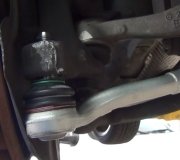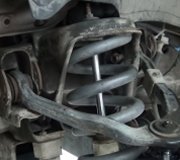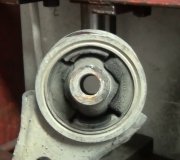The lug nuts were not tightened properly but it is important to understand, that does not mean six weeks ago. It is just as likely they were not tightened correctly by the last person who had that wheel off. Most commonly that was done by a do-it-yourselfer or an inexperienced mechanic.
Since at least as far back as the early 1980's, lug nuts need to be tightened with a click-type torque wrench. Without looking up the specific torque for your car, a common rule of thumb is 85 foot pounds for small front-wheel-drive cars with cast wheels, and 95 foot pounds with steel wheels. Light trucks are commonly in the range of around 110 to 120 foot pounds.
These values appear to be misleading at first because due to the increased leverage most torque wrenches provide, it feels like the lug nuts are not being tightened enough. They need to be tight enough so the carefully-matched friction surface between the nut and wheel holds them tight, but if they are too tight, they will grind that friction surface away and will put added stress on the studs.
The two studs most likely broke not because they were too tight, but because they were the last two holding the wheel on after the other nuts worked loose. That could be due to the others were not tight enough, or someone put grease on the studs. If your studs are silver, light yellow, or light blue, that is an anodized coating that is a lubricant. Grease will eat that away and can lead to the threads peeling the next time the nuts are removed. If you have standard lug nuts, a very light film of grease is okay, but where a lot of people run into trouble is when they think, "if some is good, more must be better". If the nuts are spun on with air tools, that wad of grease builds up ahead of the nut, and gets flung onto the friction surfaces. There, it will cause the nut to work loose. Those friction surfaces must remain dry and smooth. Also, anti-seize compound, a special type of grease, must never ever be used on lug nut studs. Doing that will get a mechanic fired because that stuff will result in lug nuts coming loose.
Another problem mechanics are often wrongfully accused of is damaging the nuts and studs when removing them. The damage was done by the last person who over-tightened the nuts. That caused the threads to peel, often to the point the nut spins but will not thread off. That nut has to be cut off with an air chisel, and some wheel designs put that nut deep in a pocket where it insures the wheel will be damaged too. If you think about it logically, the mechanic is loosening the nuts to remove them, and that is not going to damage them. Anytime your mechanic has to tell you the nuts, studs, and wheel must be replaced, blame the last person who put that wheel on months or years ago. It is common to see an experienced mechanic run the lug nuts on with air tools to save time, but they have them set to not make those nuts very tight. They will always follow that up with the torque wrench once the tires are on the ground.
The proper repair now is to replace all the studs and nuts, and the wheel. Since the nuts had to work loose before the wheel fell off, it has wobbling around deformed the friction surfaces on the wheel. Even though the nuts can be torqued to the proper tightness, the two friction surfaces will not match to hold the nuts tight. The old wheel should be damaged purposely so no one can accidentally use it and run into trouble. You can get a standard steel wheel at any salvage yard. They are not very expensive. If you have cast aluminum wheels, there are a lot of different designs and patterns. The people there will want to see one of yours so they can match it up.
We used to recommend that every customer with a car we removed a wheel from return in a few days so we could run outside and torque the lug nuts once more. There is always a chance a small piece of rust or scale broke off and got wedged behind the wheel. Once that rust grinds to powder, it could leave the lug nuts less than proper tightness. Quickly re-torquing them guards against you driving with a loose wheel. Most of us became complacent over time because we rarely found any nuts that were not fully-tightened, but with the popularity of cast aluminum wheels that are used for better fuel mileage because they are lighter, the nuts need a larger friction surface so the soft aluminum doesn't deform. That larger area and softer metal provides more chance of a small piece of debris getting stuck in there.
Be aware too the center hole in the wheel fits snugly onto the mounting surface of the hub. That holds it centered, then the nuts just hold it tight. A lot of aftermarket one-size-fits-all wheels have center holes large enough to allow them to be used on multiple applications. Now it is up to the lug nuts and studs to hold the wheel centered, and that is not a job they were designed to hold up to. Aftermarket wheels need to be built for the specific car model they are going to used on, and the lug nuts must be matched to those wheels too.
Thursday, January 11th, 2018 AT 5:49 PM




